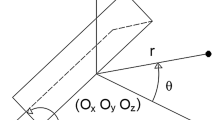Abstract
This paper presents a new method for calculating the elastic stress intensity factors for 3D structural components under complex loads and with complex geometry. To this end, a hybrid element formulation was developed where the hybrid element has its stiffness matrix corrected to exactly reflect the existence of the true 3D crack geometry within the element. To obtain the stiffness matrix of the hybrid element, this approach involves the combined use of the redundant force method together with the displacement field results arising from the finite element alternating technique (FEAT). This matrix was subsequently used together with a standard commercial finite element package to obtain the force field of the nodes. Finally, these forces were used to determine the stress intensity factors along the crack front. This procedure was validated by comparison with results available in the literature.
Similar content being viewed by others
References
Alturi, S.N. and Kathiresan, K. (1979). 3D analysis of surface flows in thick-walled reactor pressure-vessels using displacement-hybrid finite element method. Nuclear Engineering and Design 51, 163–176.
Chai, G.Z. and Zhang, K.D. (2000). A hybrid boundary element method for three-dimensional fracture analysis. International Journal of Fracture 104, 241–258.
Deif, Assem S. (1982). Advanced Matrix Theory for Scientists and Engineers, Abacus Press, U.K., 71–74.
Glinka. (1998). Approximate weight functions for embedded elliptical cracks. Engineering Fracture Mechanics 59, 381–392.
Isida, M., Hirota, K., Noguchi, H. and Yoshida, T. (1985). Two parallel elliptical cracks in an infinite solid subjected to tension. International Journal of Fracture 27, 31–48.
Jones R., Atluri, S.N., Hammond, S. and Williams J. F. (1995). Developments in the analysis of interacting cracks. Engineering Failure Assessment 2, 307–320.
Miyazaki, N., Kaneko, H. and Munakata, T. (1989). Stress intensity analyses of interacting elliptical cracks using line-spring boundary element method. International Journal of Ves. & Piping 38, 1–14.
Nishioka, T. and Atluri, S.N. (1983). Analytical Solution for Embedded Elliptical Cracks, and Finite Element Alternating Method for Elliptical Surface Cracks, Subject to Arbitrary Loadings. Engineering Fracture Mechanics 17, 247–268.
Pitt, S.D. (1996). Multi-site damage in structural components. Ph.D. thesis, University of Melbourne.
Raju, I.S. and Newman,Jr., J.C. (1979). Stress, intensity factors for a wide range of semi-elliptical surface cracks in finite-thickness Plates. Engineering Fracture Mechanics. 11, 817–829.
Trefftz, E. (1928). Handbuch der Physik, Vol. 6, Springer-Verlag, Berlin. 92.
Vijayakumar, K. and Atluri, S.N. (1981). An embedded elliptical crack, in an infinite solid, subject to arbitrary crack-face tractions. Journal of Applied Mechanics 48
ZHAO, W., WU, X.R. and YAN, M.G. (1989). Weight function method for three dimensional crack problems-II application to surface cracks at a hole in finite thickness plates under stress gradients. Engineering Fracture Mechanics 34, 609–624.
Author information
Authors and Affiliations
Rights and permissions
About this article
Cite this article
Peng, D., Jones, R. & Pitt, S. Implementation of a new algorithm for evaluating 3D fracture analysis. International Journal of Fracture 113, 57–75 (2002). https://doi.org/10.1023/A:1013771817338
Issue Date:
DOI: https://doi.org/10.1023/A:1013771817338




